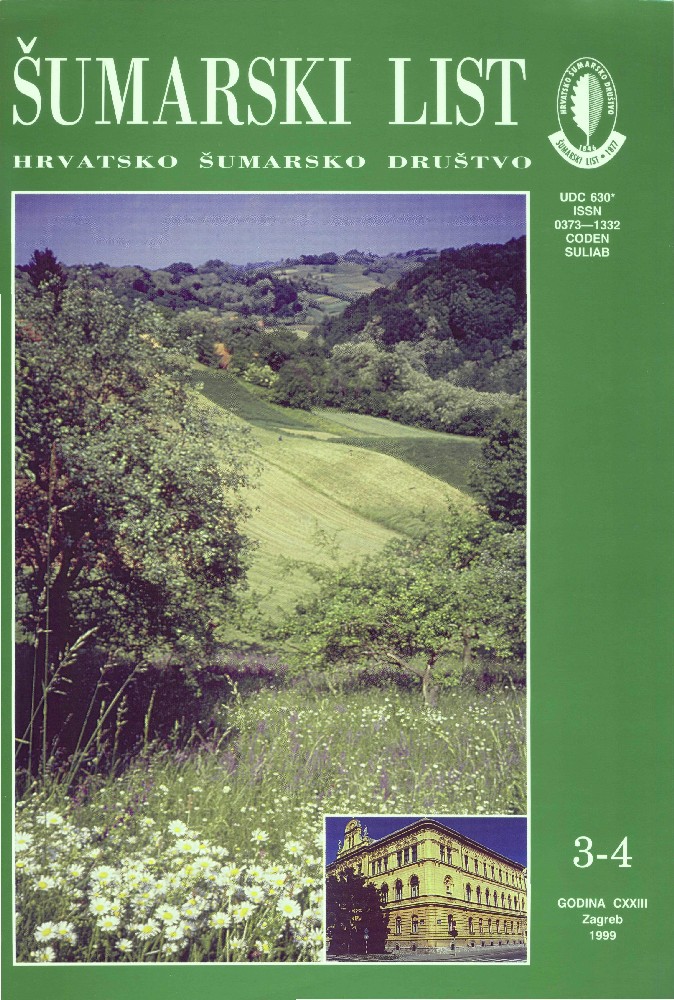
broj: 3-4/1999
pdf (20,2 MB) |
|
||||||||||||||
| IZVORNI ZNANSTVENI ČLANCI | ||
| Pleše, N., Juretić, N. | UDK 630* 444 (001) | |
| Virus Disease of Field Elm (Ulmus minor Mill.) in Croatia pdf HR EN | 95 | |
| Pernar, N., Bakšić, D., Španjol, Ž. | UDK 630* 114.2 + 235 (001) | |
| Some Characteristics of Humization in Pine Plantations on the Island of Rab pdf HR EN | 101 | |
| Summary: Humus is a complex group of organic compounds participating with 80-85% of weight in the organic soil complex in relation to dry matter. The remaining 15-20% relates to organic remains (roots and aboveground waste) that have preserved their anatomic structure, and to soil flora and fauna.The processes which lead to the accumulation of humus in the soil are included in the term humization, which is one of elementary soil-forming processes. Humization is, therefore, the accumulation of humified organic matter in the soil. It is the result of humification and mineralization. The humifying indicators of quality and quantity are very important for the study of pedogenetic processes. This paper presents initial research in three pine plantations on the island of Rab. The aim was to analyse the condition of humus in the humus-accumulative soil horizon. We were guided by the assumption that the characteristics of humization in forest ecosystems of eu-Mediterranean and sub-Mediterranean region of Croatia are reflected in: - the cycle of biogenic elements and nutritive status of soil, - the wear of parent substrate, especially in terms of soluble organogenic sediments such as Mesozoic limestones, - the soil structure, especially its surface part, and its relation to erosion, - accumulation of inflammable material on the soil surface. Soil samples were taken from the A-horizon in a 63-years-old Aleppo pine plantation growing on shallow brown soil on calcareous breccias, from an 33-years-old Aleppo pine plantation on medium deep brown soil on limestone, and from a 90-years-old culture of maritime pine on eutric brown soil on sand. Differences in the humus content and composition, as well as the nitrogen content were analysed. Differences in the humus content are particularly prominent in mean tests and standard deviation tests, where mean values range from 45.1 g kg-1 to 222.7 g kg -1. Significant differences in the participation of inert, transformation-resistant organic soil matter were revealed. These facts correspond well to humus content and to the relation between humic and fulvic acids. The ratio of humic and fulvic acids in the plantation of maritime pine on eutric brown soil is particularly prominent, and reaches 2.7, while its average in the plantations of Aleppo pine on brown soil on calcareous breccias is 0.9, and on brown soil on lime stone 0.7. Preliminary analyses of samples from the O-horizon have shown relatively low, and sometimes even negative correlative links between nitrogen content in O-subhorizons and the A-horizon, which denotes very complex relations in the transformation model of organic matter in these ecosystems. With regard to qualitative and quantitative characteristics of humus in the studied stands, a question arises of the causes of their differences, as well as of their consequences for the stability of the ecosystem. The following can be said: 1. Since this is an ecosystem with a meliorative role, these differences are an indication of different meliorative effects in given circumstances (the stands are differently aged, consist of different species and occur in different site conditions). 2. Humization is a basic pedogenetic process characterised by a dynamic balanced condition in the matter cycle of the ecosystem. The research has shown that there are different trends in humization owing to the influence of both plant species and the parent substrate. 3. Research should be carried out on a more representative sample. 4. Bearing in mind the role and importance of pine cultures in the ecosystems of eu-Mediterranean and sub-Mediterranean regions in Croatia, we believe that criteria should be drawn up for the assessment of the effects of these cultures in relation to pedological indicators and ecosystem development trends. | ||
| Kovačević, M. | UDK 630* 231 + 434 (001) | |
| Natural Regeneration of Wood and Macchia on the Burned Surfaces in Arboretum Trsteno pdf HR EN | 109 | |
| PRETHODNO PRIOPĆENJE | ||
| Grubešić, M., Dorotić, I. | UDK 630* 156 + 41.423 : 116 | |
| The Impact of Flood on Game and Hunting pdf HR EN | 119 | |
| PREGLEDNI ČLANCI | ||
| Harapin, M. | UDK 630* 453 | |
| The horse-chestnut miner (cameraria ohridella Deschka & Dimić) a dangerous pest in Europe pdf HR EN | 129 | |
| STRUČNI ČLANCI | ||
| Knepr, J. | UDK 630* 241 + 362 | |
| Simultaneous Research on the Performance of Motor Trimmers and Chain Saws pdf HR EN | 133 | |


